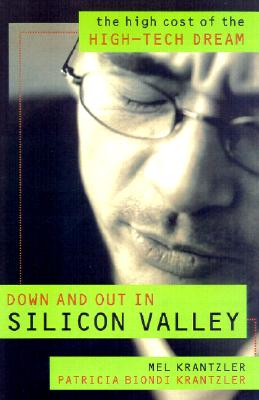

| DOWN AND OUT IN SILICON VALLEY The High Cost of the High-Tech Dream Mel Krantzler Patricia Biondi Krantzler Amherst, NY: Prometheus Books, 2002 |
Rating: 4.0 High |
|||
| ISBN-13 978-1-57392-926-? | ||||
| ISBN 1-57392-926-3 | 200pp. | HC | $? | |
The publisher's blurb says: "The first book of its kind, Down and Out in Silicon Valley is as up-to-date as today's headlines."
Despite that excess on the part of the publisher, the normally more circumspect Prometheus Books, Down and Out in Silicon Valley is actually worth reading. But uniquely new or insightful it is not. It is a fairly standard discussion of the well-known fact that many young geniuses, and some who thought they were geniuses, flocked to Silicon Valley in the wake of the invention of the personal computer to make an original contribution and become wealthy in the process — and that the most of them were disappointed.
The authors, a husband and wife team who run a relationship counselling service in Marin County, give us numerous anecdotes featuring such disappointed people. There is nothing remarkable about the insights they offer in response. They spend some time on women with powerful positions in Silicon Valley companies during the boom, but they miss many of the better-known ones such as Carol Bartz, Heidi Roizen and Ann Winblad. Over half of their chapter on women is devoted to an autobiographical sketch of Broderbund's Janese Swanson.
The best part of the book is Chapter 5. This includes case studies of GovWorks, WebVan and Paul Allen's Interval Research Corporation, which the authors describe as a Shangri-La where some of the brightest people on the planet are given carte blanche and charged with inventing the future — an idealistic attempt to recreate Bell Labs in Palo Alto:
Eight years and a staggering $250 million later, Shangri-La is a Silicon Valley ghost town. On April 21, 2000, Paul Allen prematurely—and with little fanfare—killed his grand experiment. – Page 120 |
But the book is also full of misstatements, misspelled names and grammatical errors. It misquotes John Donne's well-known passage about death, as well as Lord Acton's dictum about absolute power. The people and companies it identifies as notable or typical are often not the best choices. In the main, the best bits in these pages come from someone other than the authors: people like Paulina "Borsevh,"3 technology reporter and author of Cyberselfish; like journalist Jeff Goodell; and like T. H. Watkins of Montana State University. I rate it as worth reading, but I mark it down two notches. It's not a keeper, and I don't even consider it worth buying. There must be better books about the dot-com bust.

 To contact Chris Winter, send email to this address.
To contact Chris Winter, send email to this address.